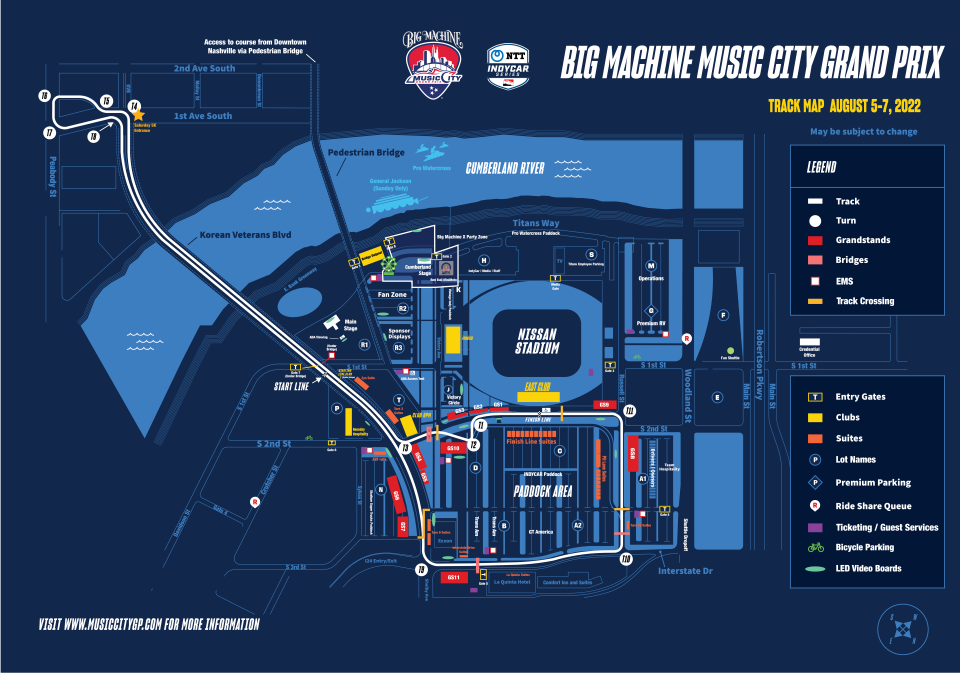Bridgestone to debut sustainable tire model at IndyCar Music City Grand Prix in Nashville
Bridgestone will debut a newly developed model of tires on every IndyCar at this weekend's Music City Grand Prix featuring sustainable, American-grown rubber.
Developed and tested over the last year, the Firestone Firehawk alternate race tires are made partly of rubber derived from the guayule plants grown on Bridgestone's 287-acre farm in Eloy, Arizona.
"The fastest tire out there will be the one that has the guayule sidewalls," said Cara Krstolic, Bridgestone's director of race tire engineering and manufacturing.
IndyCar drivers will use traditional tires for their primary tires, while the guayule tires will be used as alternate race tires.
WHAT TO KNOW: What you need to know about Music City Grand Prix
MORE CHANGES: Music City Grand Prix changes course, fan experience. Will it make for a more exciting weekend?
LAST YEAR'S RESULTS: Marcus Ericsson causes early wreck then wins crash-filled IndyCar Music City Grand Prix
In the past, Bridgestone's tires were made entirely of rubber from the hevea plant, which grows exclusively in Southeast Asia. Because the guayule plant can be grown in the United States, it requires less transportation, thus reducing Bridgestone's carbon emissions.
It also requires only about 50% of the water used to grow traditional crops like alfalfa or cotton.
"The really nice thing about this plant is that it's able to be grown in areas that are drought-ridden or affected by climate change where it's hard to grow other plants," Krstolic said.
The Firehawk tires are no different from previous tires in terms of their function. The only visible difference is that their side walls are green instead of the traditional black rubber.
The guayule testing process included extensive materials testing inside Bridgestone's research and development facilities in Mesa, Arizona, and Akron, Ohio, as well as road testing at a track in Sebring, Florida.
Graham Rahal was the first IndyCar driver to test Bridgestone's new tire model, and he said he noticed no change from the previous model.
IndyCar in Nashville: Full Big Machine Music City Grand Prix weekend schedule
Here's which streets to avoid: Grand Prix road closures underway in Nashville
That was exactly the response Krstolic was hoping for.
"Our goal going into this test was to have everything feel the same," Krstolic said. "For us, a 'no big deal' is really a good compliment."

Bridgestone conducted the test at Sebring in part because its course conditions mimic the bumpy terrain in Nashville.
Last year's Music City Grand Prix included nine caution flags and 33 of 80 laps under caution. The race was red-flagged twice. Many blamed the wrecks and other mishaps on the difficult track.
The new tires fared well under difficult testing conditions because of guayule's durability, according to Krstolic.
"In the Nashville race, you see how close they are to the walls, so it's got to protect the casing of the tire," Krstolic said.
The use of guayule is part of Bridgestone's plan to reach carbon neutrality and make tires from 100% renewable materials by 2050. Though Bridgestone only currently uses guayule in a few of its racing tires, the company aims to commercialize the use of guayule rubber in tires by 2030.
“The introduction of guayule natural rubber to America’s preeminent open-wheel racing series speaks to the confidence we have in the technology and its potential as a scalable, sustainable, and domestic source of natural rubber—a vital raw material,” said Bridgestone's chief technology officer Nizar Trigui in a statement.
Currently, only the sidewall of the Firehawk tire is made of guayule rubber. Krstolic said that Bridgestone plans to continue development in order to increase its use of guayule in its tires in the future.
"It's a good place to start," Krstolic said. "We want to make sure that we go about it in a very engineered and intentional way about substituting materials out in our race tires."
Emma Healy is a sports reporting intern for The Tennessean. Contact her at ehealy@gannett.com or follow her on Twitter @_EmmaHealy_.
This article originally appeared on Nashville Tennessean: Bridgestone to debut sustainable tires at Music City Grand Prix

